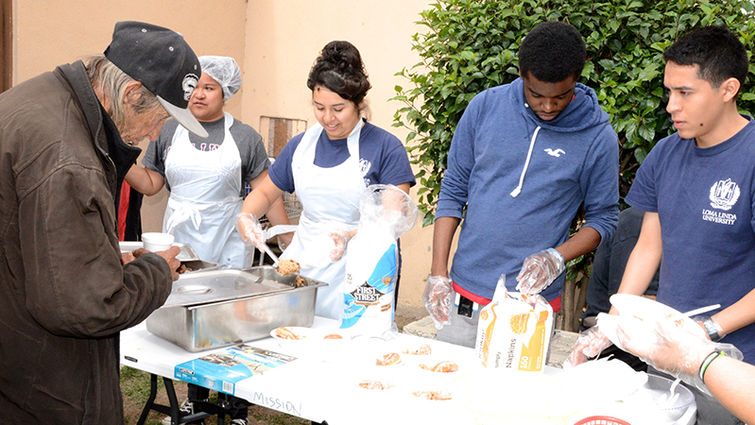
Medical radiography students from the School of Allied Health Professions feed the homeless in San Bernardino as part of a course in service-learning.
During winter quarter, 70 medical radiography students from Loma Linda University School of Allied Health Professions (SAHP) gathered at a mission in downtown San Bernardino. The students, in their first and second years in the School of Allied Health Professions, prepared and served breakfast and lunch and distributed groceries to the area’s homeless.
They also worked in the kitchen, cleaned an alley where the homeless reside and staffed a store, distributing clothing.
This wasn’t a day away from classes, according to Brenda Boyd, PhD, program director, medical radiography, SAHP. “During fall and winter quarters,” she says, “the students are required to complete 20 hours of service in the community.”
During their service-learning assignment, the students leave familiar labs and set aside time spent with imaging equipment, textbooks and journals. Why is investing time in an area so unrelated to the students’ program valuable?
“Academic service-learning is intentional,” says Boyd. “During their service, our students see firsthand where there is need in the community. As they worked on this project the students really took it over. They owned it. The group also raised $600 for the Mission, which is making a difference in the lives of the people they met.”
"Reflections are thoughtful, meaningful, and insightful writings; a life-long skill students take with them into their future health professions."Brenda Spoelstra
According to Brenda Spoelstra of the Loma Linda University Institute for Community Partnerships, “Students in service-learning courses stretch their typical university experience when the community becomes the classroom. This new classroom contains the content and material which forms the basis of their assignments.”
The experience doesn’t stop when the students leave the service-learning site.
“An element of the academic portion of service-learning is structured critical reflection,” says Spoelstra. “As the students reflect on their experience, they better understand their own perceptions and expectations of working in the community. This occurs as they sort through internal purposes of service and reactions to a community they might not be familiar with.”
More often than not the outcome of service-learning brings new perspectives about the importance of service and the community, as it applies to their future career, says Spoelstra.
Before they leave the classroom to service in the community, the students are asked to write about their expectations and assumptions about the community they will serve. Then, after they have completed the activity, they review their initial responses.
“What the students learn in the community about access to food, resources, housing, education, or health care typically transforms their initial assumptions,” Spolestra reveals. “While they may have studied theories in class or while reading academic articles, their initial writing often gets a fine-tuned revision after they have rolled up their sleeves and served in the community.”
“As the students respond to unexpected situations at the service-learning site they experience real-life circumstances that they combine with what they are learning in the classroom."
"Service-learning programs open our eyes to what is needed and how we can be a part of making things better."LLU service-learning participant
“In their reflections,” says Spoelstra, “students often express an eye-opening experience to the great need within our underserved region and a commitment to on-going community engagement in their own lives.“
They also often comment that there is no video, book or lecture that could teach them what they learned in the community.
While service-learning is a part of each of Loma Linda University’s programs, the medial radiography students’ experiences are common.
At the mission, a student who had served nearly 100 people, including families with babies, wrote: “At first I was disappointed that I had not made any special connections with anyone. Then I understood that I should not have come to this activity expecting something from somebody else just for me. Instead, I learned a lesson from serving them and that is what I needed.”
"The change I noticed most about myself was how I was more judgmental before working alongside the homeless. As I realized that in God’s eyes we are all the same, I grew as a human being and became more kind. The world needs more kindness."LLU service-learning participant
As they completed their 20 hours of service, the students no longer felt out of place at the mission. The experience was so meaningful that they students, working together, have adopted the mission.
This is gratifying to Boyd. “While in health care we have the power,” she says. “During their work at the mission, the students experienced what it is like to serve for the sake of serving.”
“Our hope,” says Spoelstra, “is that as Loma Linda University students participate in service-learning, they become both well-informed health care professionals and service-minded health care professionals concerned with the whole person and the community.”
